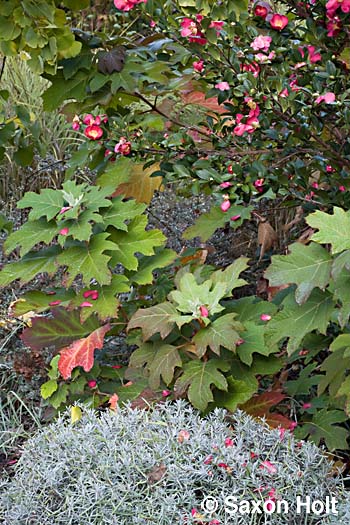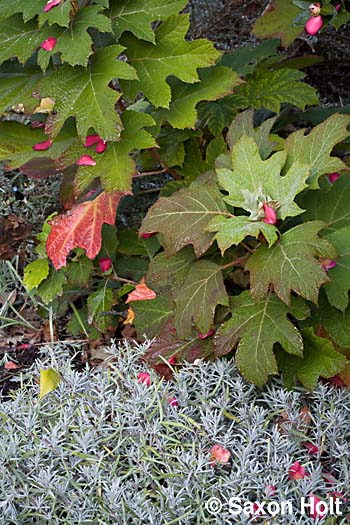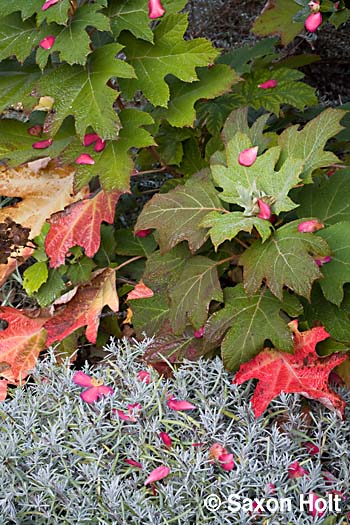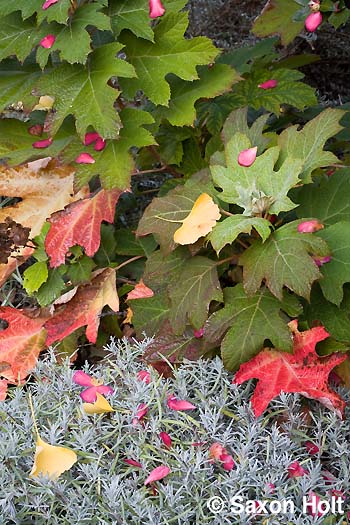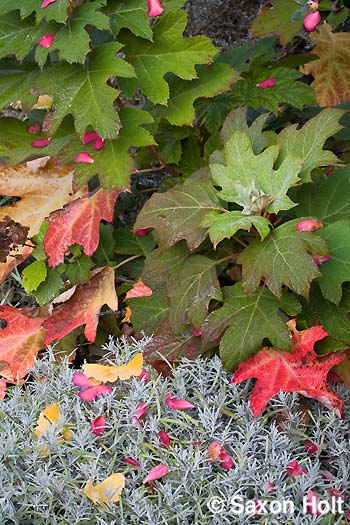No matter what kind of garden you have or what kind of camera you work with, the single most important thing to remember when you take the picture is to ask yourself why you are taking it. What do you see ?
I have given several presentations recently about taking pictures in the garden and recently put my advice to work in my own garden – then went one step further to “enhance” what I saw. The camera always lies anyway, so why not embellish the story…..
It is a great time of year in my front garden. I plant lots of things for fall color and the miraculous symphony slowly proceeds, all by itself, from September through December. This year I cut back my low hedge of Lavender ‘Fred Boutin’ earlier than usual, to keep it more compact next year. The daffodils (already beginning to bloom elsewhere in my garden) appreciate the extra room resulting from an early lavender shear. To anyone not living in Northern California the absurd notion of having autumn, winter, and spring all at the same time seems incomprehensible. But true. Anyway, the neat, gray lavender border became a foil for all the color which is now peaking and I wanted to capture it in the camera.
What am I seeing ? What is it about the garden that gives me the shivers ? That first photo is not bad as an illustration vignette of my shrub border, Camellia, Hydrangea, Lavender, but doesn’t capture my sudden fascination in the gray foliage. The first photo is not what I am “seeing”, not what I am feeling about this unexpected encounter with December color. That essence is in the gray foliage and transient color that has just happened. To capture a moment is my goal, to reveal something that an ordinary photo does not do, is my work. To distill that moment, first I need to move in a bit tighter than my first “grab” shot. Using a tripod and my camera viewfinder, I frame a pleasing composition. Upper 2/3 dominated by Hydrandea quericifolia ‘Alice’, bottom 1/3 by Lavender ‘Fred Boutin’
The essence of what I “saw” in my my border is beginning to take shape as I isolate the key elements, but the photo is not strong enough yet. My mind sees the gray lavender as a foil to lots more color than the photo is showing, so now is the time to make the composition say what I want it to say. What is “really” there, in this moment, is not being revealed by the camera; so I need to enhance the scene. Let’s add color:
Now we are getting somewhere ! I have placed a few colorful hydrangea leaves in the frame and dropped in more Camellia petals. Hmmm, long as I am going this far, what else might it need ? I look carefully through the viewfinder and contemplate. And add some more:
The butter yellow Ginkgo leaves bring in another dimension that my heart “saw” in the garden but the camera did not. As I studied my photograph through the viewfinder I realized I must add the yellow warmth I feel in the garden. The yellow is not just a nice touch to the composition but it is there in my mind as I walk the garden. It is what my garden is “about” right now.
So I help along my composition to suit my heart. At this point the photograph is not about literal reality but about what I really feel. Should I consider some more changes ? Are the Ginkgo petals too obviously out of place ? Do I want to get rid of the dark hole in the upper right side of he composition ? Let’s try this:
I don’t know which of the last two I like the best but at this point, with all the artistic license I have granted myself, it does not make much difference – the elements are in place. When I first walked into the garden and saw the camellia petals on the Hydrangea leaves and gray lavender, the mere newness of this moment and unexpected beauty made me want to make a photograph. As I thought about what I was seeing and forced myself to get down to picture through the static frame of the camera, I was also thinking about what I wanted the photo to say.
In my December garden the transient beauty of color is enhanced by gray. I had never seen that before. Now I can “see” it forever.

